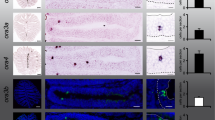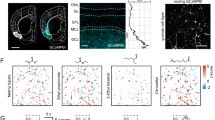Abstract
The mouse's sense of smell is built of ∼1000 input channels. Each of these consists of a population of olfactory sensory neurons that express the same odorant receptor gene and project their axons to the same targets (glomeruli) in the olfactory bulb. A neuron must choose to express a singular receptor gene from a repertoire of ∼1000 genes, and its axon must be wired to the corresponding glomerulus, from an array of ∼1800 glomeruli. Genetic experiments have shown that the expressed odorant receptor specifies axonal choice of the innervated glomerulus, but it is not the only determinant. The mechanisms of odorant receptor gene choice and axonal wiring are central to the functional organization of the mammalian olfactory system. Although principles have emerged, our understanding of these processes is still limited.
This is a preview of subscription content, access via your institution
Access options
Subscribe to this journal
Receive 12 print issues and online access
$209.00 per year
only $17.42 per issue
Buy this article
- Purchase on Springer Link
- Instant access to full article PDF
Prices may be subject to local taxes which are calculated during checkout

Bob Crimi

Bob Crimi

Bob Crimi

Bob Crimi
Similar content being viewed by others
References
Firestein, S. How the olfactory system makes sense of scents. Nature 413, 211–218 (2001).
Buck, L. & Axel, R. A novel multigene family may encode odorant receptors: a molecular basis for odor recognition. Cell 65, 175–187 (1991).
Mombaerts, P. Molecular biology of odorant receptors in vertebrates. Annu. Rev. Neurosci. 22, 487–509 (1999).
Mombaerts, P. Seven-transmembrane proteins as odorant and chemosensory receptors. Science 286, 707–711 (1999).
Mombaerts, P. The human repertoire of odorant receptor genes and pseudogenes. Annu. Rev. Genomics Hum. Genet. 2, 493–510 (2001).
Glusman, G., Yanai, I., Rubin, I. & Lancet, D. The complete human olfactory subgenome. Genome Res. 11, 685–702 (2001).
Zozulya, S., Echeverri, F. & Nguyen, T. The human olfactory receptor repertoire. Genome Biol. 2, 0018.1–0018.12 (2001).
Xie, S. Y., Feinstein, P. & Mombaerts, P. Characterization of a cluster comprising ∼100 odorant receptor genes in mouse. Mamm. Genome 11, 1070–1078 (2000).
Tsuboi, A. et al. Olfactory neurons expressing closely linked and homologous odorant receptor genes tend to project their axons to neighboring glomeruli on the olfactory bulb. J. Neurosci. 19, 8409–8418 (1999).
Bulger, M. et al. Conservation of sequence and structure flanking the mouse and human β-globin loci: the β-globin genes are embedded within an array of odorant receptor genes. Proc. Natl. Acad. Sci. USA 96, 5129–5134 (1999).
Malnic, B., Hirono, J., Sato, T. & Buck, L. B. Combinatorial receptor codes for odors. Cell 96, 713–723 (1999).
Rawson, N. E. et al. Expression of mRNAs encoding for two different olfactory receptors in a subset of olfactory receptor neurons. J. Neurochem. 75, 185–195 (2000).
Chess, A., Simon, I., Cedar, H. & Axel, R. Allelic inactivation regulates olfactory receptor gene expression. Cell 78, 823–834 (1994).
Strotmann, J. et al. Local permutations in the glomerular array of the mouse olfactory bulb. J. Neurosci. 20, 6927–6938 (2000).
Ishii, T. et al. Monoallelic expression of the odourant receptor gene and axonal projection of olfactory sensory neurons. Genes Cells 6, 71–78 (2001).
Ressler, K. J., Sullivan, S. L. & Buck, L. B. A zonal organization of odorant receptor gene expression in the olfactory epithelium. Cell 73, 597–609 (1993).
Vassar, R., Ngai, J. & Axel, R. Spatial segregation of odorant receptor expression in the mammalian olfactory epithelium. Cell 74, 309–318 (1993).
Strotmann, J., Konzelmann, S. & Breer, H. Laminar segregation of odorant receptor expression in the olfactory epithelium. Cell Tissue Res. 284, 347–354 (1996).
Sullivan, S. L., Bohm, S., Ressler, K. J., Horowitz, L. F. & Buck, L. B. Target-independent pattern specification in the olfactory epithelium. Neuron 15, 779–789 (1995).
Strotmann, J., Wanner, I., Helfrich, T. & Breer, H. Receptor expression in olfactory neurons during rat development: in situ hybridization studies. Eur. J. Neurosci. 7, 492–500 (1995).
Buck, L. B. Information coding in the vertebrate olfactory system. Annu. Rev. Neurosci. 19, 517–544 (1996).
Alenius, M. & Bohm, S. Identification of a novel neural cell adhesion molecule-related gene with a potential role in selective axonal projection. J. Biol. Chem. 272, 26083–26086 (1997).
Yoshihara, Y. et al. OCAM: a new member of the neural cell adhesion molecule family related to zone-to-zone projection of olfactory and vomeronasal axons. J. Neurosci. 17, 5830–5842 (1997).
Norlin, E. M. & Berghard, A. Spatially restricted expression of regulators of G-protein signaling in primary olfactory neurons. Mol. Cell. Neurosci. 17, 872–882 (2001).
Ressler, K. J., Sullivan, S. L. & Buck, L. B. Information coding in the olfactory system: evidence for a stereotyped and highly organized epitope map in the olfactory bulb. Cell 79, 1245–1255 (1994).
Vassar, R. et al. Topographic organization of sensory projections to the olfactory bulb. Cell 79, 981–991 (1994).
Mombaerts, P. et al. Visualizing an olfactory sensory map. Cell 87, 675–686 (1996).
Mori, K., Nagao, H. & Yoshihara, Y. (1999). The olfactory bulb: coding and processing of odor molecule information. Science 286, 711–715.
Nagao, H., Yoshihara, Y., Mitsui, S., Fujisawa, H. & Mori, K. Two mirror-image sensory maps with domain organization in the mouse main olfactory bulb. Neuroreport 11, 3023–3027 (2000).
Buck, L. B. The molecular architecture of odor and pheromone sensing in mammals. Cell 100, 611–618 (2000).
Mombaerts, P. Targeting olfaction. Curr. Opin. Neurobiol. 6, 481–486 (1996).
Qasba, P. & Reed, R. R. Tissue and zonal-specific expression of an olfactory receptor transgene. J. Neurosci. 18, 227–236 (1998).
Ebrahimi, F. A., Edmondson, J., Rothstein, R. & Chess, A. YAC transgene-mediated olfactory receptor gene choice. Dev. Dyn. 217, 225–231 (2000).
Ebrahimi, F. A. & Chess, A. Olfactory neurons are interdependent in maintaining axonal projections. Curr. Biol. 10, 219–222 (2000).
Serizawa, S. et al. Mutually exclusive expression of odorant receptor transgenes. Nat. Neurosci. 3, 687–693 (2000).
Reed, R. R. Regulating olfactory receptor expression: controlling globally, acting locally. Nat. Neurosci. 3, 638–639 (2000).
Pyrski, M. et al. The OMP-lacZ transgene mimics the unusual expression pattern of OR-Z6, a new odorant receptor gene in mouse. J. Neurosci. 21, 4637–4348 (2001).
Sosinsky, A., Glusman, G. & Lancet, D. The genomic structure of human olfactory receptor genes. Genomics 70, 49–61 (2000).
Bulger, M. et al. Comparative structural and functional analysis of the olfactory receptor genes flanking the human and mouse β-globin gene clusters. Proc. Natl. Acad. Sci. USA 97, 14560–14565 (2000).
Hoppe, R., Weimer, M., Beck, A., Breer, H. & Strotmann, J. Sequence analyses of the olfactory receptor gene cluster mOR37 on mouse chromosome 4. Genomics 66, 284–295 (2000).
Lane, R. P. et al. Genomic analysis of orthologous mouse and human olfactory receptor loci. Proc. Natl. Acad. Sci. USA 98, 7390–7395 (2001).
Borst, P. & Ulbert, S. Control of VSG gene expression sites. Mol. Biochem. Parasit. 114, 17–27 (2001).
Wang, F., Nemes, A., Mendelsohn, M. & Axel, R. Odorant receptors govern the formation of a precise topographic map. Cell 93, 47–60 (1998).
Rodriguez, I., Feinstein, P. & Mombaerts, P. Variable patterns of axonal projections of sensory neurons in the mouse vomeronasal system. Cell 97, 199–208 (1999).
Pasterkamp, R. J., De Winter, F., Holtmaat, A. J. & Verhaagen, J. Evidence for a role of the chemorepellent semaphorin III and its receptor neuropilin-1 in the regeneration of primary olfactory axons. J. Neurosci. 18, 9962–9976 (1998).
Schwarting, G. A. et al. Semaphorin 3A is required for guidance of olfactory axons. J. Neurosci. 20, 7691–7697 (2000).
Treloar, H., Tomasiewicz, H., Magnuson, T. & Key, B. The central pathway of primary olfactory axons is abnormal in mice lacking the N-CAM-180 isoform. J. Neurobiol. 32, 643–658 (1997).
Belluscio, L., Gold, G. H., Nemes, A. & Axel, R. Mice deficient in G(olf) are anosmic. Neuron 20, 69–81 (1998).
Lin, D. M. et al. Formation of precise connections in the olfactory bulb occurs in the absence of odorant-evoked activity. Neuron 26, 69–80 (2000).
Zheng, C., Feinstein, P., Bozza, T., Rodriguez, I. & Mombaerts, P. Peripheral olfactory projections are differentially affected in mice deficient in a cyclic nucleotide-gated channel subunit. Neuron 26, 81–91 (2000).
Bulfone, A. et al. An olfactory sensory maps develops in the absence of normal projection neurons or GABAergic interneurons. Neuron 21, 1273–1282 (1998).
Nef, S., Lush, M. E., Shipman, T. E. & Parada, L. F. Neurotrophins are not required for normal embryonic development of olfactory neurons. Dev. Biol. 234, 80–92 (2001).
Royal, S. J. & Key, B. Development of P2 olfactory glomeruli in P2-internal ribosome entry site-tau-lacZ transgenic mice. J. Neurosci. 19, 9856–9864 (1999).
Potter, S. M., Zheng, C., Koos, D. S., Feinstein, P., Fraser, S. E. & Mombaerts, P. Structure and emergence of specific olfactory glomeruli in the mouse. J. Neurosci. (in press).
Bailey, M. S., Puche, A. C. & Shipley, M. T. Development of the olfactory bulb: evidence for glia–neuron interactions in glomerular formation. J. Comp. Neurol. 415, 423–448 (1999).
Treloar, H. B., Purcell, A. L. & Greer, C. A. Glomerular formation in the developing rat olfactory bulb. J. Comp. Neurol. 413, 289–304 (1999).
Zhao, H. & Reed, R. R. X inactivation of the OCNC1 channel gene reveals a role for activity-dependent competition in the olfactory system. Cell 104, 651–660 (2001).
Schaefer, M. L., Finger, T. E. & Restrepo, D. Variability of position of the P2 glomerulus within a map of the mouse olfactory bulb. J. Comp. Neurol. 436, 351–362 (2001).
Bozza, T. C. & Mombaerts, P. Olfactory coding: revealing intrinsic representations of odors. Curr. Biol. 11, R687–R690 (2001).
Costanzo, R. M. Rewiring the olfactory bulb: changes in odor maps following recovery from nerve transection. Chem. Senses 25, 199–205 (2000).
Cummings, D. M., Emge, D. K., Small, S. L. & Margolis, F. L. Pattern of olfactory bulb innervation returns after recovery from reversible peripheral deafferentation. J. Comp. Neurol. 421, 362–373 (2000).
Gogos, J. A., Osborne, J., Nemes, A., Mendelsohn, M. & Axel, R. Genetic ablation and restoration of the olfactory topographic map. Cell 103, 609–620 (2000).
Author information
Authors and Affiliations
Corresponding author
Rights and permissions
About this article
Cite this article
Mombaerts, P. How smell develops. Nat Neurosci 4 (Suppl 11), 1192–1198 (2001). https://doi.org/10.1038/nn751
Received:
Accepted:
Published:
Issue Date:
DOI: https://doi.org/10.1038/nn751
This article is cited by
-
The role of the odorant receptors in the formation of the sensory map
BMC Biology (2021)
-
Determination of quasi-primary odors by endpoint detection
Scientific Reports (2021)
-
Topographic organization in the olfactory bulb
Cell and Tissue Research (2021)
-
Data-driven nanomechanical sensing: specific information extraction from a complex system
Scientific Reports (2017)



